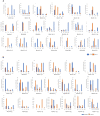Genome-wide identification and expression analysis of the GRAS gene family under abiotic stresses in wheat (Triticum aestivum L.)
- PMID: 37907517
- PMCID: PMC10618205
- DOI: 10.1038/s41598-023-45051-0
Genome-wide identification and expression analysis of the GRAS gene family under abiotic stresses in wheat (Triticum aestivum L.)
Abstract
The GRAS transcription factors are multifunctional proteins involved in various biological processes, encompassing plant growth, metabolism, and responses to both abiotic and biotic stresses. Wheat is an important cereal crop cultivated worldwide. However, no systematic study of the GRAS gene family and their functions under heat, drought, and salt stress tolerance and molecular dynamics modeling in wheat has been reported. In the present study, we identified the GRAS gene in Triticum aestivum through systematically performing gene structure analysis, chromosomal location, conserved motif, phylogenetic relationship, and expression patterns. A total of 177 GRAS genes were identified within the wheat genome. Based on phylogenetic analysis, these genes were categorically placed into 14 distinct subfamilies. Detailed analysis of the genetic architecture revealed that the majority of TaGRAS genes had no intronic regions. The expansion of the wheat GRAS gene family was proven to be influenced by both segmental and tandem duplication events. The study of collinearity events between TaGRAS and analogous orthologs from other plant species provided valuable insights into the evolution of the GRAS gene family in wheat. It is noteworthy that the promoter regions of TaGRAS genes consistently displayed an array of cis-acting elements that are associated with stress responses and hormone regulation. Additionally, we discovered 14 miRNAs that target key genes involved in three stress-responsive pathways in our study. Moreover, an assessment of RNA-seq data and qRT-PCR results revealed a significant increase in the expression of TaGRAS genes during abiotic stress. These findings highlight the crucial role of TaGRAS genes in mediating responses to different environmental stresses. Our research delved into the molecular dynamics and structural aspects of GRAS domain-DNA interactions, marking the first instance of such information being generated. Overall, the current findings contribute to our understanding of the organization of the GRAS genes in the wheat genome. Furthermore, we identified TaGRAS27 as a candidate gene for functional research, and to improve abiotic stress tolerance in the wheat by molecular breeding.
© 2023. The Author(s).
Conflict of interest statement
The authors declare no competing interests.
Figures








Similar articles
-
Evolutionary analysis of GRAS gene family for functional and structural insights into hexaploid bread wheat (Triticum aestivum).J Biosci. 2021;46:45. J Biosci. 2021. PMID: 34047288
-
Genome-wide identification and expression analysis of the GSK gene family in wheat (Triticum aestivum L.).Mol Biol Rep. 2022 Apr;49(4):2899-2913. doi: 10.1007/s11033-021-07105-2. Epub 2022 Jan 27. Mol Biol Rep. 2022. PMID: 35083611
-
Genome-wide identification of TaeGRASs responsive to biotic stresses and functional analysis of TaeSCL6 in wheat resistance to powdery mildew.BMC Genomics. 2024 Nov 27;25(1):1149. doi: 10.1186/s12864-024-11041-3. BMC Genomics. 2024. PMID: 39604842 Free PMC article.
-
Genome-wide identification and expression analysis of the Dof gene family reveals their involvement in hormone response and abiotic stresses in sunflower (Helianthus annuus L.).Gene. 2024 Jun 5;910:148336. doi: 10.1016/j.gene.2024.148336. Epub 2024 Mar 4. Gene. 2024. PMID: 38447680 Review.
-
Cis-Regulation by NACs: A Promising Frontier in Wheat Crop Improvement.Int J Mol Sci. 2022 Dec 6;23(23):15431. doi: 10.3390/ijms232315431. Int J Mol Sci. 2022. PMID: 36499751 Free PMC article. Review.
Cited by
-
Identification of two new GRAS transcription factors and expression analysis of these genes in Chenopodium quinoa.Front Plant Sci. 2025 Jul 18;16:1579338. doi: 10.3389/fpls.2025.1579338. eCollection 2025. Front Plant Sci. 2025. PMID: 40755825 Free PMC article.
-
Genome-wide characterization of GRAS gene family and their expression profiles under diverse biotic and abiotic stresses in Amorphophallus konjac.BMC Genomics. 2025 Jul 8;26(1):643. doi: 10.1186/s12864-025-11777-6. BMC Genomics. 2025. PMID: 40629278 Free PMC article.
-
Transcription factors in Orinus: novel insights into transcription regulation for speciation adaptation on the Qinghai-Xizang (Tibet) Plateau.BMC Plant Biol. 2025 Apr 29;25(1):560. doi: 10.1186/s12870-025-06602-x. BMC Plant Biol. 2025. PMID: 40301765 Free PMC article.
-
Functional characterization of AsGRAS24 in Avena sativa reveals its role in enhancing salt tolerance via antioxidant and hormonal regulation in transgenic Arabidopsis thaliana.BMC Plant Biol. 2025 Aug 20;25(1):1102. doi: 10.1186/s12870-025-07061-0. BMC Plant Biol. 2025. PMID: 40836209 Free PMC article.
-
Dissection of QTLs underlying the genetic basis of drought resistance in wheat: a meta-analysis.Theor Appl Genet. 2025 Jan 9;138(1):25. doi: 10.1007/s00122-024-04811-w. Theor Appl Genet. 2025. PMID: 39786445
References
Publication types
MeSH terms
Substances
LinkOut - more resources
Full Text Sources

